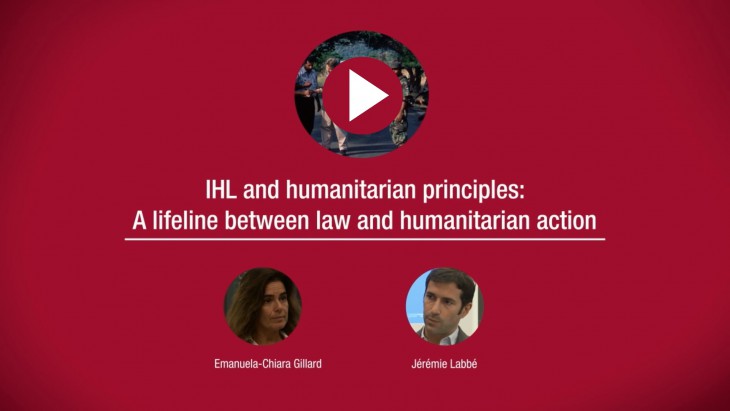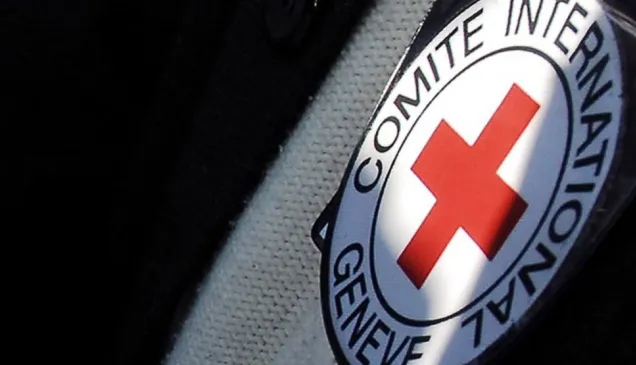IHL and humanitarian principles
The Advanced IHL Learning Series are addressed to lecturers and trainers who wish to be abreast of the latest developments in international humanitarian law (IHL) and other related areas. The series help lecturers strengthen their grasp of topical issues and gives them access to teaching resources, thereby enabling them to introduce these topics or issues in the courses or training sessions that they run.
The Advanced IHL Learning Series combine theory and practice and make use of videos, reading materials and various other teaching tools. Many of the resources are taken from the 2015 edition of the Advanced Seminar in IHL for University Lecturers and Researchers. The videos feature lectures by speakers at the seminar, and discussions between them and participants. The opinions expressed by the lecturers in the series are theirs alone, and not necessarily shared by the ICRC.
Introduction to IHL and humanitarian principles
Since the seven Fundamental Principles of the International Red Cross and Red Crescent Movement were adopted in 1965 by the Twentieth International Conference of the Red Cross, they have provided a pragmatic operational framework for humanitarian work worldwide. By crystallizing the Movement's century-long humanitarian practice in the field, the principles were intended to ensure effective humanitarian action to help all those affected by armed conflicts, other situations of violence and natural disasters. They promote an operational approach dictated solely by existing humanitarian needs. Beyond their practical and legal dimensions, the principles reflect a high ideal of humanity, morality and universality. Yet, humanitarian action was born not from an abstract idea but on the battlefield. The principles are therefore only valid insofar as they manifest in concrete realities, such as in response to humanitarian needs arising from armed conflict. In that regard, understanding the close interaction between humanitarian principles and international humanitarian law is crucial for any lecturer addressing the topic.
The Fundamental Principles
Humanity
The International Red Cross and Red Crescent Movement, born of a desire to bring assistance without discrimination to the wounded on the battlefield, endeavours, in its international and national capacity, to prevent and alleviate human suffering wherever it may be found. Its purpose is to protect life and health and to ensure respect for the human being. It promotes mutual understanding, friendship, cooperation and lasting peace amongst all peoples.
Impartiality
It makes no discrimination as to nationality, race, religious beliefs, class or political opinions. It endeavours to relieve the suffering of individuals, being guided solely by their needs, and to give priority to the most urgent cases of distress.
Neutrality
In order to continue to enjoy the confidence of all, the Movement may not take sides in hostilities or engage at any time in controversies of a political, racial, religious or ideological nature.
Independence
The Movement is independent. The National Societies, while auxiliaries in the humanitarian services of their governments and subject to the laws of their respective countries, must always maintain their autonomy so that they may be able at all times to act in accordance with the principles of the Movement.
Voluntary service
It is a voluntary relief movement not prompted in any manner by desire for gain.
Unity
There can be only one Red Cross or one Red Crescent Society in any one country. It must be open to all. It must carry on its humanitarian work throughout its territory.
Universality
The International Red Cross and Red Crescent Movement, in which all Societies have equal status and share equal responsibilities and duties in helping each other, is worldwide.
Learning objectives
At the end of the series, users will be able to:
- better understand the ideals and spirit guiding the International Red Cross and Red Crescent Movement
- explain the origin, purpose and relevance of the principles
- grasp the respective natures of, and understand the interplay between, humanitarian principles and IHL principles
- distinguish between the substantive, operational and institutional nature of the principles
- identify how the Geneva Conventions and other sources of IHL stipulate how relief activities are to be conducted in conformity with the humanitarian principles
- identify and discuss current challenges to contemporary humanitarian action
- understand how the ICRC applies humanitarian principles in practice.
Structure of the course
- Required and suggested readings: before watching the videos, lecturers and humanitarian professionals are invited to familiarize themselves with the topic by working their way through the required and suggested reading.
- Videos: the entire session can then be watched at once, or by chapter, depending on the need and specific interest of each user. Videos can also be watched and discussed in class, as an introduction to the topic triggering questions and debate.
- Teaching tools: ICRC tools on how to teach IHL as well as specific, ready-to-use teaching materials on IHL and humanitarian principles are available. Lecturers are encouraged to use them to integrate the topic in their course or training.
- Further reading and resources: lecturers and humanitarian professionals are encouraged to further explore the topic via additional resources (e.g. ICRC statements, publications, event reports) about IHL and humanitarian principles and related topics. Researchers may wish to use them as informative sources for their research projects on this topic.
Speaker biographies
Jérémie Labbé, ICRC
Jérémie Labbé has been heading up the "Principles Guiding Humanitarian Action" project at the ICRC since July 2014. Prior to this, he worked for the International Peace Institute (IPI) in New York, where he developed a new programme on humanitarian affairs. His work has focused on adapting the international humanitarian system to a changing world, the relevance of humanitarian principles, protection of civilians and international humanitarian law, and the relationship between humanitarian action and UN integration. Before joining the IPI in 2010, Jérémie spent several years with the ICRC, both at headquarters in Geneva (Legal Division) and on various field missions in India, Ethiopia, Sri Lanka, Madagascar and Iraq.
Emanuela-Chiara Gillard, Oxford Institute for Ethics, Law and Armed Conflict / European University Institute
From 2007 to 2012 Emanuela-Chiara Gillard was chief of the Protection of Civilians Section in the Policy Development and Studies Branch of the United Nations Office for the Coordination of Humanitarian Affairs (OCHA). Prior to that, she spent seven years as legal adviser at the ICRC. There she was responsible for advising headquarters and field colleagues on legal issues relating to: the protection of civilians in armed conflict, especially children; assistance activities; multinational forces; occupation; and private military/security companies. Before joining the ICRC, Emanuela was a legal adviser at the United Nations Compensation Commission. And from 1995 to 1997 she was a research fellow at the Lauterpacht Centre for International Law at the University of Cambridge. Emanuela holds a B.A. in Law and an LL.M. from the University of Cambridge. She is a Solicitor of the Senior Courts of England and Wales.
Reading materials
Required reading
- "ICRC Q&A and lexicon on humanitarian access", International Review of the Red Cross, Vol. 96, No. 893, Spring 2014, pp. 359–375
- Bouchet-Saulnier, Francoise, "Consent to humanitarian access: An obligation triggered by territorial control, not States' rights", International Review of the Red Cross, Vol. 96, No. 893, Spring 2014, pp. 207–217
- Gillard, Emanuela-Chiara, "The law regulating cross-border relief operations", International Review of the Red Cross, Vol. 95, No. 890 (Part II), Summer 2013, pp. 351–382
- Labbé, Jérémie, "How do humanitarian principles support humanitarian effectiveness?", On the road to Istanbul: How can the World Humanitarian Summit make humanitarian response more effective?, CHS Alliance, August 2015
- Pictet, Jean, The Fundamental Principles of the Red Cross: Commentary, Geneva, 1979, pp. 5–11
Suggested reading
- Humanitarian Access in Situations of Armed Conflict, Handbook on the International Normative Framework, Version 2, December 2014, Swiss Federal Department of Foreign Affairs (FDFA), the ICRC, OCHA, and Conflict Dynamics International
- Humanitarian Access in Situations of Armed Conflict, Practitioners' Manual, Version 2, December 2014, FDFA, OCHA and Conflict Dynamics International
- Donini, Antonio, "Between a rock and a hard place: integration or independence of humanitarian action?", International Review of the Red Cross, Vol. 93, No. 881, March 2011
- O'Callaghan, Sorcha, and Leach, Leslie, "The relevance of the Fundamental Principles to operations: learning from Lebanon", International Review of the Red Cross, Vol. 95, No. 890 (Part II), Summer 2013, pp. 287–307
- Krähenbühl, Pierre, "The ICRC's approach to contemporary security challenges: A future for independent and neutral humanitarian action", International Review of the Red Cross, Vol. 86, No. 855, September 2004
- Terry, Fiona, "The ICRC in Afghanistan: Reasserting the neutrality of humanitarian action", International Review of the Red Cross, Vol. 93, No. 881, March 2011
Watch the videos
The course is divided into several sessions. Click on a title to watch the video.
- Outline of the course (3’)
- Humanitarian principles: Origins and definition (15’)
- Humanitarian principles: Operational relevance (3’)
- IHL and humanitarian principles: Introduction (2’)
- IHL and humanitarian principles: Addressees and sources (17’)
- Humanitarian principles: Dilemma exercise (11’)
- IHL and humanitarian principles: Regulating relief operations (20’)
- IHL and humanitarian principles: Future challenges and perspectives (3’)
Specific teaching tools on IHL and humanitarian principles
- ICRC booklet The Fundamental Principles of the International Red Cross and Red Crescent Movement
- E-briefing on “Principles guiding humanitarian action”
- ICRC workshop on humanitarian principles and action
- International Review of the Red Cross, “Principles guiding humanitarian action”, Vol. 97, No. 897/898
- How Does Law Protect in War, “Humanitarian Access and IHL”
- How Does Law Protect in War, “Fundamental principles of IHL”
- How Does law Protect in War, “Red Cross and Red Crescent Principles”
- How Does law Protect in War, “Humanitarian Assistance”
Further reading and resources
- ICRC Research and Debate Cycle on Principles Guiding Humanitarian Action
- Code of conduct for the International Red Cross and Red Crescent Movement
- ICRC statement, “Humanitarian Principles – the importance of their preservation during humanitarian crises” (2007)
- Report and audio recording of the ICRC panel discussion “Humanitarian principles revisited? Current and future challenges” (2013)
- Report and video recording of the ICRC event “Principles in action: How do neutrality and independence contribute to humanitarian effectiveness?” (2015)
- Personal stories about the Fundamental Principles




